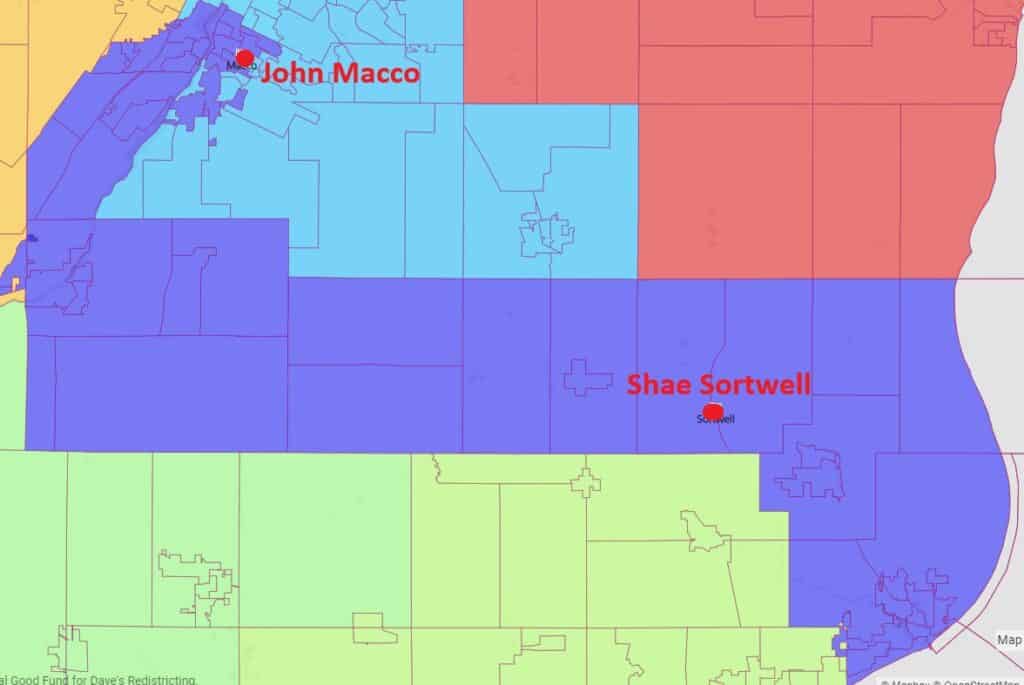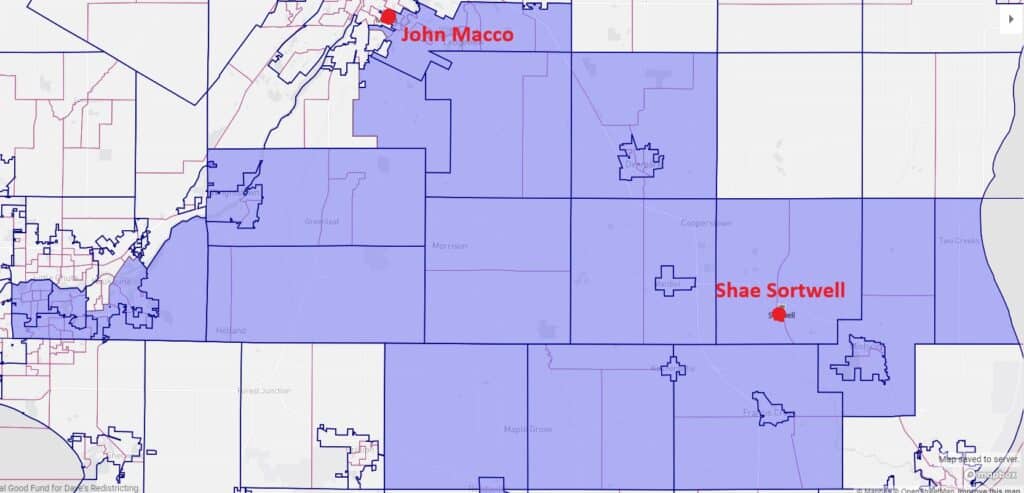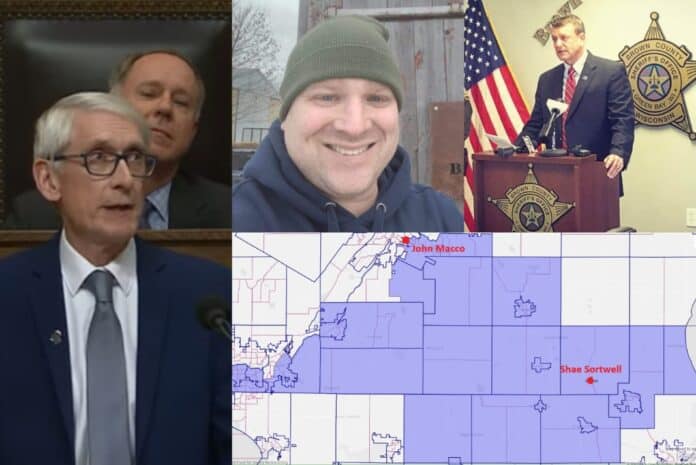Democrats and Gov. Tony Evers “are trying to minimize the power of the Republican conservative vote,” – state Rep. John Macco, a Republican, on the new maps proposals.
In a ruthless partisan power play, Democratic Gov. Tony Evers, who falsely promised to submit “fair maps,” has pitted two popular Republican incumbents – Shae Sortwell and John Macco – together in a newly drawn district in the Fox Valley and Manitowoc County area.
Sortwell confirmed WRN’s analysis, saying that it “appears to be the case in both the Evers’ map and the Democratic Senate map” that he is paired with Macco, a fellow Republican. We also confirmed their addresses with Sortwell and Macco.
Current Map of District 2 (Sortwell) and District 88 (Macco)

Gov. Evers Proposed Map of District 2

Sortwell said the pairing, if Evers’ maps are chosen by the liberal-controlled state Supreme Court, would leave Macco and Sortwell with terrible options. They’d either have to battle it out in a Republican primary, one would have to quit the Legislature, or “one of us would have to move,” he said.
But that’s easier said than done. Moving “would be a huge financial hit on my family,” said Sortwell, who is married with six kids, and is a home owner. His family “lives a mile down the road.” Plus, the real estate market is not strong right now for purchasing another home.
“It’s about tying us all down. Taking away the advantage of incumbency,” – state Rep. Shae Sortwell
Macco agreed with these sentiments. Of the pairing between him and Sortwell, Macco asked, “Do you expect me to relocate? To sell my house in three months time?” Not to mention that it’s a bad real estate market to sell a house. “It’s manipulative and intentional,” he said. He said he built his home and has lived there for 23 years.
In the state Assembly, Evers’ maps pair about 30 incumbents with each other and, of those, about 25 are Republican-against-Republican pairings and only one is Democrat-against-Democrat. In the state Senate, approximately 13 incumbents were paired in about six Senate districts; of those, about 10 are Republican, the analysis showed. Only one is a Democrat-Democrat pairing, and one of those Democrats is likely leaving the legislature to run for county executive. Although we are focusing on Evers’ maps, some of the other Democratic maps also contain multiple Republican incumbent pairings that are just as egregious.
We previously wrote about another Republican incumbent pairing in Evers’ maps: He paired powerful state Assembly Majority Leader Tyler August with fellow Republican Amanda Nedweski in a newly drawn district, missing putting August with Speaker Robin Vos by six houses. August tells WRN that Evers’ maps left him with very little of his old district, essentially stripping the power of incumbency away from him, in addition to putting him against a fellow Republican who retains more of her original district.
We also revealed that Evers’ maps pit Republican incumbents Dan Knodl and Duey Stroebel together in a hotly contested and reshaped Senate district near Milwaukee. In addition, his maps stripped the more Republican areas from that district.
Wisconsin Right Now is dedicated to doing stories on each of the Republican pairings to educate the public.
‘The Epitome of Gerrymandering’
“If you wanted to see the epitome of gerrymandering, my district for the last 20 years has been the east side of Brown County. Now the district is the west side of Green Bay,” Macco said. But he’s no longer in it. Evers’ maps stick Macco into Sortwell’s newly drawn district.
If Macco wants to remain the representative of the 88th Assembly District, if Evers’ maps are chosen, he would “have to leave my home and move to the west side of Green Bay where nobody knows me.” In addition, he said Evers stripped core constituencies out of his district, such as the University of Wisconsin-Green Bay and Boys and Girls clubs he’s worked closely with.
Macco, a Republican businessman who lives in DePere, has been in the state Assembly since 2014, representing Assembly District 88.

Sketching out what the Democrats are trying to do overall, Macco said: “I think they are trying to minimize the power of the Republican conservative vote. There is only so much you can do in Rhinelander or up north, so they are focusing on Madison, Green Bay, Milwaukee – higher population districts with more liberal folks – and they are using the wheel-and-spoke method to eliminate or minimize the voice of conservatives.”
He said the Democrats want to render the voices of conservatives in his current district “null and void, so they control the entire narrative.”
Sortwell has similar concerns. He has been tossed into a newly drawn area he’s not very connected to and pitted against Macco beside.
“They also strip both of my population centers, so I don’t have either Two Rivers or De Pere in the Evers’ maps,” Sortwell said. Two Rivers has been in the second Assembly district “for at least 40 years.” Sortwell said Evers also spun De Pere into a new district that Democrats will have a better chance of winning.
Sortwell, whose voting address is in Two Rivers per the legislature’s website, is a Republican military veteran who was elected to the State Assembly in 2018, to represent Assembly District 2.

The new Evers’ maps make a series of partisan moves targeting Sortwell.
“It takes out both of my population centers,” Sortwell said of the new Evers’ maps. He said they also gave him the community where Macco lives to disadvantage Sortwell.
It’s still a Republican district but now includes parts of Appleton, where he has “never had any connection” as a legislator. He has a Two Rivers address, but now would not represent Two Rivers. He also questioned why the maps place Manitowoc and Two Rivers together in a newly drawn district, saying, “Everyone from Manitowoc and Two Rivers knows putting them in the same district makes no sense; there is a huge rivalry between those whole towns.”
He believes the pairing is Democrats “trying to eliminate any advantage of incumbency so you don’t have any connections with any of these folks.”
In another Democratic set of maps, Sortwell said he would be paired instead against Republican incumbent Paul Tittl, showing the complete chaos the liberal-controlled Supreme Court has injected into Wisconsin’s electoral process.
“Are they targeting me or targeting John Macco? I don’t know,” said Sortwell. “It’s about tying us all down. Taking away the advantage of incumbency and making the district a little more competitive.” He said he is the number three “door knocker” in the state Legislature, not only for himself but for other legislators, and he said the new scenario would result in less time for him to door knock.
He said Evers created a “new District in De Pere” with a couple other areas, adding, “It looks to me that leans Democrat.”
The liberals on the court shoved aside the conservative chief justice after seizing the majority, so they could usurp her scheduling authority. They then rushed through the newly filed case on the redistricting maps, which liberal Justice Janet Protasiewicz prejudged on the campaign trail, labeling the Legislature’s maps “rigged.”
Macco said there are many manipulative and partisan aspects to Evers’ and the other Democratic maps, and the pairing is just part of it.
For example, he said the maps split municipalities, which would be confusing and unfair to voters. The new maps “swiped a bunch of Bellevue and gave it to another district,” he explained, as but one example. “I think it’s absolutely terrible what this does to local government. Towns and villages should be outraged.” He said that the new maps violate continuity required by the state Constitution “in chopping governments like that.”
He believes the Democratic maps ignored continuity concerns and “only looked at how blue or purple they can make it.” To do this, they turned districts into “spoken wheels,” he said. “It’s really strange. It has nothing to do with continuity. They ignored it.”
Macco said all of this could have been avoided if Democrats had accepted Republicans’ officer to accept the “Iowa plan” for redistricting. Instead, he said Evers and the other Democrats who submitted plans are “trying to engineer a win-lose.”
He also challenged the liberal argument that the breakdown of the state Legislature “is supposed to represent the overall state vote.” As with the electoral college, dividing the legislature based on the overall state vote totals for Democrats and Republicans would rob rural areas of a voice in state government, favoring only a few populous areas, Macco said. That’s not what the Founding Fathers desired, he said.
A couple key points to remember:
The state Constitution gives the Legislature, Republican-controlled now, the authority to redistrict. Evers promised to veto anything the Republicans put forward, so it headed into the courts.
The state Supreme Court, with sometime conservative Justice Brian Hagedorn joining the liberals, recently chose a previous set of Evers’ maps, but the US Supreme Court threw them out because of how they dealt with race. Hagedorn then switched to the conservative side, and the state Supreme Court chose the Legislature’s maps because they offered the least change.
Immediately after Protasiewicz was elected with $10 million from the state Democratic Party, the state Supreme Court’s new liberal majority reversed itself and threw out protocol and legal doctrine when it tossed out the legislature’s maps, ruling that they were unconstitutional because they included municipal islands. Those are just little pieces of annexed land that don’t have many people, if any, on them.
That’s even though the liberals on the court, Evers himself and federal courts had previously indicated that municipal islands were allowed under a definition of “contiguity.” The municipal islands simply followed municipal boundaries, and that’s also a requirement of the Constitution. Thus, many conservatives see what the court did as an attempt to find a tactic to accomplish its real goal: Gaming the maps for Democrats.
Macco said that municipal islands simply followed municipal boundaries, so they retained the same identity as the districts they were in; by that definition, he believes his current district was “substantially more contiguous” than the newly drawn ones.
The now liberal-controlled state Supreme Court then pushed forward a warp-speed timeline over Christmas and thrust the state’s electoral system into chaos. Legislators, some of whom were recently elected, have no idea which district they will have to run in next.
Seven sets of maps were submitted. The Legislature’s maps focused on dissolving the municipal islands into their surrounding districts, since this was the supposed problem the court chose. Five sets of maps are perceived to be favoring Democrats, including Evers’.
The court then chose two handpicked, out-of-state and unelected consultants to wade through the submissions and propose maps to the court. This is all supposed to happen by Feb. 1, giving the public little time to understand what is in the map proposals. The court will eventually settle on the final maps, setting up rushed elections for next November.
Although some in the media have claimed the different sets of maps would still narrowly give Republicans a majority, those stories are missing the fact that this can be gamed and changes depending on which election or elections you use to calculate the partisan slant of any given district. Experts behind the scenes are still sorting through how that all shakes out, but it’s clear that Democrats gain significantly under all of the sets of maps. One Marquette Law analysis indicates that some of the maps outright give Democrats control of the state Senate, which they do not have now.
“Notably, the Senate Democrats plan and the Petering (FastMap) plans both create outright Democratic majorities, according to my model of the 2022 election,” that analysis reads, but there are other models to measure partisan tilt.
Democrats are trying to seize the state Senate and Assembly from Republicans so they can ram through a wish list of liberal policies in Wisconsin such as those seen in California and Minnesota.
Most of the news stories also do not contemplate how the pairings of Republican incumbents could affect the outcomes of the elections in newly drawn districts. A district might be coded as leaning Republican, but if it no longer has a Republican incumbent or one will be knocked out, that gives Democrats an extra edge the media are not reporting.
Table of Contents











![Governor Caught Playing Politics with Brillion Residents’ Lives & Livelihood [COLUMN] ron tusler](https://www.wisconsinrightnow.com/wp-content/uploads/2025/07/MixCollage-15-Jul-2025-03-35-PM-9568-356x220.jpg)


![Protecting Portland: No Good Deed Goes Unpunished [REVIEW]](https://www.wisconsinrightnow.com/wp-content/uploads/2025/07/portland-356x220.jpg)


















